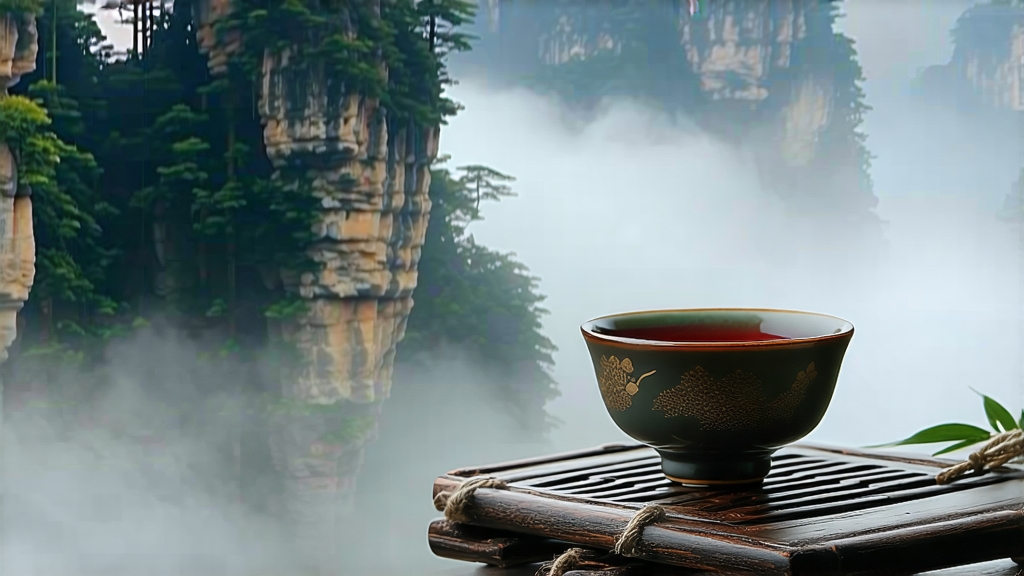
High in the Wuyi Mountains of northern Fujian, where the Min River cuts sheer granite into tooth-shaped cliffs, a small group of tea bushes has been quietly working for more than 350 years. Locals call them the “mother trees” of Da Hong Pao—Big Red Robe—the most celebrated of China’s rock oolongs (yancha). According to Qing-dynasty records, a scholar on his way to the capital imperial exams fell gravely ill at the mountain monastery; the monks brewed leaves from these bushes, restored him overnight, and the young man went on to place first in the palace examinations. To express gratitude he returned in crimson silk, draping the bushes as if robing them in imperial red. The story may be legend, but the flavor is fact, and every serious tea traveler still climbs the narrow plank paths above the Nine-Dragon Gorge to taste the mineral breath of stone that no other tea can imitate.
Strictly speaking, Da Hong Pao is both a proprietary name and a style. The six original mother trees, perched on a ledge called Jiulongke, are now protected and no longer harvested; the last 20 g of their leaf, taken in 2006, sold for 1.02 million RMB. What reaches the market today falls into three categories: 1) pedigree cuttings (called “purebred” or qizhong) grown from clones of the mother trees; 2) blended “commodity” Da Hong Pao that marries several Wuyi cultivars such as Rou Gui, Shui Xian, and Tie Luo Han to approximate the original profile; 3) “old bush” teas from ungrafted shrubs rooted in the same cliff micro-terroir. Each tier offers a different dialogue between rock and leaf, but all must obey the Wuyi geography: a band of volcanic tuff soil no wider than 60 km, 600–750 m elevation, 85 % humidity, and a diurnal swing that forces the leaves to thicken their cell walls, trapping aromatic oils that will later translate into yanyun—the elusive “rock rhyme” that connoisseurs describe as a cool, stony echo that arrives minutes after swallowing.
Harvest begins in late April, when three half-open leaves and the terminal bud are plucked at the “zhong kai mian” stage—when the bud stands slightly taller than the top leaf. The pluckers work from 8 a.m. to 1 p.m., before the sun turns too fierce, laying the green in bamboo baskets lined with linen to prevent bruising. Once back at the cottage, the leaf is withered on bamboo racks set in the courtyard, turned every twenty minutes so the mountain breeze can carry away grassy aldehydes. At dusk the real art starts: shaking. Forty kilos of leaf are dumped into a rattan drum 1.2 m wide; two men grip the rim and rock it back and forth, letting the edges collide. This controlled bruising ruptures 20–25 % of the cells, initiating oxidation while the veins remain green. The process is repeated five times across the night, each shake gentler than the last, until the leaf edge turns a coppery maroon and the aroma drifts from cut grass to toasted orchid. At 3 a.m. the master kills the enzymes in a 270 °C electric wok, hand-tossing the leaves for exactly 87 seconds—any longer and the charcoal notes will dominate, any shorter and the soup will taste raw. While still warm, the leaf is rolled, first loosely to shape the strip, then under 23 kg of pressure to squeeze residual moisture into the stem, a step that will later allow multiple infusions. After a brief rest, the maocha is sorted, destemmed, and given its first charcoal firing.
Charcoal roasting is the signature of Wuyi yancha and the step most misunderstood abroad. The tea is laid in shallow rattan trays stacked inside a brick oven; atop a pit of glowing embers from local hardwoods (mostly longan and lychee) the temperature is kept at 75 °C for three hours, then allowed to cool for seven. This cycle is repeated two to four times over the next three months, each round lowering the temperature by 5 °C. The goal is not to add smoke but to drive moisture from the hollow stem while caramelizing residual sugars, creating notes of molasses, pipe tobacco